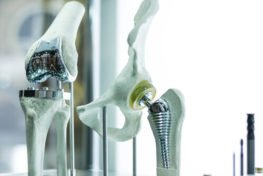Stryker Hip Implant Lawyers

Stryker Hip Implant Lawsuits and Lawyers
Although the Stryker ABG II-Modular-Neck Hip Stem and Rejuvenate hip replacement systems were designed as a safer alternative to earlier metal-on-metal hip implants, such as the DuPuy ASR hip implant system, thousands of lawsuits have been filed based on similar adverse side effects. Stryker announced a voluntary recall of both of these hip implants on July 6, 2012. The Food and Drug Administration (FDA) has received numerous adverse event reports complaining of complications associated with “fretting” and corrosion, which causes particles of metal to slough off into patients bones, tissue, and bloodstream.
Free Confidential Case Evaluation: If you have suffered serious complications after implantation of a Stryker hip implant, Stern Law, PLLC invites you to contact us immediately at 844-808-7529 for a free case evaluation. You may be entitled to financial compensation, and attorney Ken Stern and his staff can answer your questions and explain your rights.
What Are the ABG II Modular-Neck Hip Stem and Rejuvenate Hip Implant Systems?
These neck-stem implants differ from typical hip implant systems based on a “monoblock design.” The conventional design includes a single piece for the neck and stem. The Rejuvenate and the ABG II include multiple stems and necks. This innovation was intended to allow surgeons the benefit of components that offered a more anatomically accurate fit based on the specific patient. The implants were not supposed to undergo corrosion and fretting from friction of the neck and stem junction like previously recalled ball and cup metal-on-metal implants. The stem components of the two recalled hip implant systems are made of a proprietary titanium alloy blend comprised of zirconium, titanium, iron, and molybdenum. This titanium blend was not supposed to be vulnerable to fretting and corrosion.
Why Stryker Neck and Stem Implant Systems Were Recalled
The Stryker neck and stem hip implant systems were designed to mitigate the risk of fretting and corrosion caused by the friction of metal-on-metal experienced with prior recalled hip replacement systems. However, thousands of people have filed lawsuits after experiencing similar complications. The neck components of the two recalled hip replacement systems are comprised of cobalt and chromium while the stems are coated with titanium. Although these implants are not technically metal-on-metal implants, they undergo similar deterioration when the metallic parts wear against each other where the neck and stem intersect.
The ABG II and Rejuvenate hip replacements shed metal particles causing severe complications. When the metallic debris leeches into the bloodstream, bones, and tissues, patients can suffer Adverse Local Tissue Reactions (ALTR) when metal ions invade surrounding cells.
The abnormally high levels of metal ions can lead to the following complications:
- Necrosis (premature death of tissue or bone)
- Severe pain necessitating revision surgery
- Osteolysis (deterioration of bone)
- Pseudotumor formation
- Premature device failure
- Metallosis (metal poisoning)
- Severe allergic reactions
- ALTR (inflammation)
Some studies also have suggested a link between absorbed metal ions and heart problems, neurological issues, and damage to organs that include the spleen, kidneys, lymph nodes, and liver. Cobalt is considered an exceptionally toxic substance inside the human body.
Since the stem components of these hip implants are driven deep into the femur, revision surgery is difficult for surgeons and risky for patients. The revision surgery typically involves more intense pain than the original procedure to implant the hip replacement. Further, the femur might be weakened by abnormally high levels of metal ions, which increase the risk of fractures during the revision surgery. Patients have been exposed to repeated revision surgeries, multiple fractures, and reconstruction of the femur.
Stryker Issues “Urgent Field Safety Notice” & Voluntary Recall
The FDA received sixty adverse event reports involving fretting, corrosion, and metal toxicity of the ABG II and Rejuvenate hip implants. In response to these reports, Stryker issued an “Urgent Safety Alert” in April 2012 indicating the risk of “excessive metal debris and/or ion generation” caused by fretting and corrosion at the junction of the neck and stem. According to the alert, this sloughing of metallic debris could result in excessive levels of metal ions in the surrounding joint space. As adverse event reports continued to flow into the FDA, Stryker announced a voluntary recall of both the ABG II and Rejuvenate hip implants three months after issuing the safety alert. The Canadian health authority also recalled these two Stryker implants before the device manufacturer’s voluntary recall.
Issues Involving Stryker’s Reimbursement Program
While Stryker has announced a reimbursement program for patients implanted with the ABG II and Rejuvenate hip implant system, patients without legal counsel might find that this program is a trap for the unwary. Broadspire Services, Inc., a third-party risk management company, is managing the reimbursement program. The first problem with this program is that patients are only being compensated for “testing, treatment, revision surgery, and other costs related to the recall.” This compensation presumably does not include pain and suffering, disability, emotional distress, or impaired quality of life. In other words, a personal injury lawsuit will provide access to pursue far more extensive compensation. The second problem with the reimbursement program is that patients are being required to execute medical authorization forms. If patients execute these documents, they are surrendering their right to privacy of their medical records and permitting a search for medical information that can be used to mitigate the amount received by the patient.
Thousands of Stryker Hip Replacement Lawsuits Filed in State and Federal Courts
Stryker defective hip replacement lawsuits have been consolidated into multi-district litigation (MDL) in two separate states. Over 1,700 lawsuits are part of the MDL in New Jersey while hundreds of lawsuits are part of the MDL in Minnesota. Plaintiffs have also filed cases in state courts throughout the U.S. Some of these lawsuits already have settled.
Some representative examples of plaintiffs who have filed lawsuits against Stryker based on complications associated with their defective hip replacement include the following:
- Branko Obradovic: Obradovic was forced to undergo revision surgery a mere fifteen months after receiving his hip implant. He reports that staying still is extremely difficult and that climbing out of his vehicle is an ordeal.
- Cheryl Helder: Cheryl received a hip replacement in August 2010 and then the other hip was replaced in October 2011. When doctors found abnormally high levels of metal ions and fluid in the region of the devices, she was forced to endure two additional revision surgeries at the site of each implant. In other words, Cheryl underwent a total of six surgeries.
- Tracy Sponder: Sponer was forced to undergo revision surgery one year after she received her hip implant.
- Diane Pingel: Pingel has two of the faulty hip replacement devices implanted. Physicians determined that the cobalt level in her blood was abnormally elevated. She also experienced dying tissue, pockets of fluid, and necrosis of tissue and bone. The metal debris in her body caused her bone to die, and her femur fractured during the revision surgery.
While the allegations vary depending on the specific lawsuit, some of the allegations pursued in state or federal court include:
- The manufacturer failed to respond appropriately to early reports of device failure.
- Stryker misrepresented that the hip replacements would not fret or corrode.
- The device maker falsely represented the hip replacement system offered a safe alternative to metal-on-metal implants.
- The company continued selling device despite awareness of poor performance of the device regarding premature implant failure, metal ions impacting cells, tissues and the bloodstream.
- Stryker utilized false and deceptive marketing.
Symptoms of Complications from Stryker Hip Replacement Fretting and Corroding
If you received a hip implant, you should review your hospital records to determine if you were implanted with an implant that has been recalled. If you are unable to determine the type of hip implant you received, we invite you to contact us so that we can help you identify your hip replacement and evaluate your legal claim.
The FDA has indicated that development of certain symptoms three months or more after implant of the ABG II and Rejuvenate hip implant systems include:
- Diminished mobility or limping
- Pain in the groin, hip, or leg
- Clicking, grinding, squeaking, popping, and clicking from the hip joint
- Swelling in the vicinity of the hip joint
Speak with a Proven and Compassionate Stryker Hip Implant Attorney
Stryker defective implant attorney Ken Stern is accepting lawsuits from patients who have experienced serious complications after implantation of these medical devices. He can advise you about pursuing an individual lawsuit in state court or joining the MDL litigation in federal court. Stern Law, PLLC is committed to helping our defective Stryker hip implant clients obtain the financial compensation they need quickly. We invite you to contact Stern Law, PLLC today at (844) 808-7529 or submit an online form for assistance.













